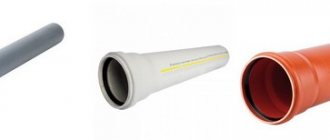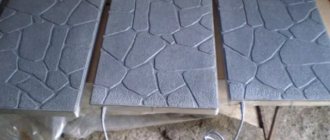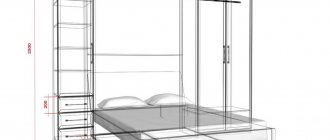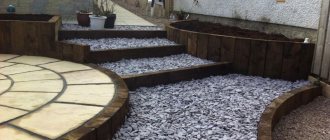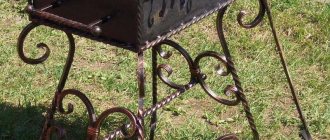When building a house and landscaping a site, it is often necessary to make round holes in the ground. They are needed when constructing a fence - for installing poles, when building gazebos, installing arches and other light utility structures. The same holes, but with a larger diameter and depth, are required when constructing a pile foundation. These holes are made with a motorized or hand drill. There are plenty of them in stores, but many people prefer homemade ones: they are often more productive and reliable than factory-made products. In addition, you can make a drill with your own hands of any design, and there are many of them.
Designs and Applications
There are three main designs of earth drills:
- Garden. Usually these are two semicircular blades welded at an angle to one another. A hand drill of this design is used to organize holes for planting plants, which is why it is called “garden”. But the same tool is used to make holes when installing posts for fences, gazebos and other light buildings.
An example of a homemade earthen garden auger - Auger drill. It differs in that it has a longer cutting part. It is used for the same purposes - to make holes for pillars. Due to its design - a longer cutting part - it needs to be removed less often, so drilling usually goes faster.
The auger drill is distinguished by spirally wound several turns of the spiral - Drill for TISE piles. This design is similar to a garden auger, but has an additional folding blade to form the expansion at the bottom of the pile characteristic of this type of foundation.
Folding blade - features of the TISE pile drill
Garden earth drills that are easier to make. Depending on the type of soil on which drilling is carried out, their design is slightly modified. This is the beauty of homemade drills - they can be “sharpened” to specific conditions and it’s not just about the size - the blades can be made removable, bolted on, but also about the design features. Yes, ordinary drills in the store are inexpensive, but they are “universal”. They work well on “light” soils.” On loams, clays, marl, etc. they are ineffective.
Preparing for independent drilling
Before making a drill for drilling a well with your own hands, you should determine the following factors:
- Estimated depth of the water basin . If the water layer is located at a depth of no more than 10 m, the well can be awakened by any of the 4 methods above. For water intake with a surface electric pump, a small channel cross-section is sufficient, so it is more rational and simpler to use driving technology using a needle drill or screw penetration with a small diameter drill. If you plan to use a submersible pump in a column of standard casing pipes, a bailer or spoon-type structure is made. For drilling to great depths, as well as to shallow ones, there are no competitors to auger hydraulic drilling in terms of speed and efficiency; the use of the percussion-rope method with a bailer or a spoon drill is significantly inferior in time to auger drilling using water and may turn out to be economically unprofitable due to high physical stress and significant loss of time.
- Well diameter . For water intake from depths greater than 9 m from the surface level, you will need to use a submersible electric pump, which requires the use of a large diameter casing; in this case, drilling can be carried out using any of the above methods. An effective option for sinking clay structures is to use drilling in the casing, in which water is poured into it, and the soil in the form of liquid mud is extracted out with a bailer or spoon device.
Homemade spoon drills
Making a garden drill
A garden auger is the simplest but most effective design. It consists of:
- Cutting part. It usually consists of two steel semicircles with sharpened edges. The diameter of the blades is selected depending on the diameter of the holes that need to be drilled. For convenience, the blades can be made removable - bolted.
The post drill can be equipped with a prefabricated rod - Kernel. This is a round or profiled pipe (square cross-section). A crowbar can also be used, but it is very heavy and will be difficult to work with. The length of the rod is the required depth of the hole plus 50-60 cm. If you make it shorter, then the last centimeters will have to be drilled in a deep slope, which is not at all easy. If this calculation results in a total height higher than 1.5 meters, it makes sense to make a prefabricated rod. Then the rod is extended with pipe sections of the same diameter, creating an articulation system.
- Pen. Most often, a crossbar in the shape of the letter T is welded to the rod. The minimum length of the handle is 40 cm, the optimal length is about 50-60 cm.
- The tip is a drill. This is the part that is under the blades. It is the first to loosen the soil, and at the initial stage it is responsible for centering the drill - it is easier to hold it vertically.
This is a basic design, and there are many modifications to it. But let's first talk about what an earth drill can be made from.
Materials
As already mentioned, the rod is most often made from a round or square pipe. Diameter - from 3/4′ to 1.5′, profiled pipe can be taken from 20*20 mm to 35*35 mm.
Blade knives can be made from:
- sheet steel with a thickness of 4 mm;
- saw blade for an angle grinder of suitable diameter.
Earth drill with blades made from a saw blade for an angle grinder
It is easier to make blades from a saw blade. In this case, the cutting edges are already ready. It will be possible to further sharpen the side edges to make the soil easier to cut.
The spear-drill is made from different materials - there are many different designs. They just make a sharpened rod. Then you need a piece of large diameter rod. The second option is to make something like a drill from the steel strip. And yet - a combination of these two.
Steel strip earth auger bit
Pike - one of the tip options
Combination tip for crushing rocks
And finally - about the pen. It is more convenient if it is made of a round pipe. Its diameter can be selected according to the circumference of the palms. The main requirement is that you should be comfortable.
Knives and fastening method
First of all, you need to decide whether you are making a drill with your own hands with removable or stationary blades. If the blades are removable, weld shelves made of thick steel at one end of the rod. The shelves are made at an angle - so that the planes of the knives are separated at an angle of 25-30°.
After the shelves are welded, two or three holes are made in them for fasteners. Then the same holes will need to be made in the blades, and installed on bolts of substantial diameter.
One rod can have several sets of cutting blades - for holes of different diameters
You will have to cut holes in the center of the disks themselves so that they fit more tightly to the rod, but this operation is also required for the monolithic version - with welded blades.
Sheet steel
If you are going to make the blades from sheet steel, cut out a template from paper and use it to create a circle of steel. Drill a hole in the center - you will need to insert and weld a rod into it. Circle or square - depending on the chosen rod. The hole dimensions are slightly larger than the dimensions of the rod.
Next, you need to decide what kind of blades you will make - from two halves of a circle (as in the photo above) or in the form of an open circle with offset edges - one turn of a spiral (in the photo below).
Manual drill with one turn
The edges should also be separated by 25-30 degrees. In this case, drilling efficiency will be maximum. If you work on dense soils (clay, loams with a predominance of clay), the blades may collapse under load. To avoid this, stops are added from a corner or a thick strip of steel.
Strengthening a hand drill for drilling wells in dense soils
The blades bend due to the fact that unhardened steel is used, but it is almost impossible to find it in the sheet, and even if it is possible, it is unlikely to be bent.
From a saw blade
If you have an old saw blade of a suitable diameter, you have found an almost ideal option. They use hardened steel, which is elastic and durable. But such a disk cannot be bent, so it is sawed in half and these halves are placed at the required angle.
The disc is sawn in half
This homemade drill for excavation works shows quite high productivity. Even used wheels have a well-ground edge. And to make drilling even easier, they also sharpen the drill on the sides with their own hands.
Modifications
In dense soils, it can be difficult to cut the soil with large blades. In this case, several blades of different sizes are welded onto the rod. From below, near the peak, the smallest ones are welded; above, retreating a few centimeters, the large ones are welded. There can be three such tiers, maximum four. The entire cutting part should not be more than 50 cm, otherwise it is physically very difficult to work.
Cutting blades can be arranged in several tiers
If a drill is needed for shallow holes - for installing poles, etc., then this design is optimal - it is relatively light in weight and easy to work with. The working process is as follows: they lowered it into the hole, turned it several times, pulled it out, and poured out the soil stuck between the blades. But if you need to drill deep holes, you will suffer from carrying a small amount of soil from the depths. For such cases, a box for collecting soil is welded above the blades.
A homemade drill with an earth receiver is suitable for installing poles and piles
And all these are hand-made drills. All of them are highly efficient - it’s much easier to work than store-bought ones.
Methods for connecting drill pipes
To drill long distances, the drill is extended under water using hollow steel pipes of standard diameters 21.3, 26.8 and 33.5 mm with a length of 1500 to 2000 mm, which are connected to each other in the following ways:
Threaded. In this technology, for connection, an external thread is used, which is cut at one pipe end, and an internal thread on transition couplings, which are short cylindrical sections with a diameter corresponding to the lower point of the pipe thread notch. Cutting is carried out manually with dies using die holders according to the old Soviet method or with modern, more convenient devices - cutters. After applying threads to the inner side of the transition couplings and the outer shell of the pipes at one end, a coupling is welded to their other edge, and extension is carried out by screwing subsequent pipes into the couplings of the previous ones.
Bolt and threaded coupling . With this method, a large diameter bolt is welded to one end of the pipe, and a long nut in the form of a coupling with an internal thread corresponding to the external thread of the bolt is welded to the other, and when connecting the pipe elements, they are screwed onto each other until they stop. The technology is reminiscent of joining factory-produced drill rods; factory connecting heads can be welded or screwed to threads instead of bolts and couplings.
Bolting and heads for drill rods
Pin . Joining pipes using a pin is the most optimal method, ensuring high speed of connection and disassembly of extension rods. To implement it, an internal coupling is welded to one side of each pipe, the next pipe is put on it and holes are drilled in them at some distance from the edge. Then a pin is inserted into the through channel of the two joined pipes, preventing them from being separated.
The disadvantage of pin fastening is the possibility of falling out of the holes; the easiest way to eliminate this disadvantage is to use a threaded bolt with a nut for fastening. True, this solution is ineffective for a quick connection; moreover, when used in the ground, the thread is constantly clogged with dirt, which significantly slows down the assembly and disassembly of the extension pipeline. It is more effective to use a pin with a lock, which is a rotating plate embedded in its end, similar to the design used for assembling scaffolding. But this system also has the disadvantage of using individual elements that can be lost; also, when the extension rod pipes rotate in hard soil, there is a high probability of deformation and damage to the weakened pin ends with limiting plates.
Pin designs
The best method for solving problems associated with the disadvantages of pin connections is to use a special design in which a U-shaped plate with an inserted pin is welded to the pipe opposite the through hole, and a restrictive pin is inserted into its body through a through radial channel. The limiter prevents the pin from being lost and falling out of the assembly, and is also an element with the help of which the pin is moved along the through hole, connecting and disconnecting the pipeline. Also, the outer U-shaped steel plate protects the pin and stop from damage when rotating in the ground.
If the above design seems too complicated to be manufactured at home, a good option is to purchase a factory-made pin for attaching soil drills, which is a bolt with smooth walls, in the head of which a hole is drilled and a rigid wire stop is inserted, which goes around the pipe and is put on on the other side to the end of a smooth-walled bolt.
Option for quickly connecting a borehole drill with pins
Auger drill
Due to the large number of turns, an auger auger creates significant resistance, that is, it is much more difficult to work with it than with a garden auger. But augers are used mainly in the presence of a mechanized drive - when making a drill for deep wells - for water, for installing underground probes for a heat pump, etc.
This is what an auger drill looks like
To make a homemade auger drill, you will need several metal disks. The number of disks is equal to the number of turns. The disks are cut identically, a hole is cut in them in the center for the rod, as well as an identical sector - so that they can be welded.
A sector is marked in the rings and cut out
The discs are welded on one side, then, slightly stretching the resulting accordion, the seam is welded on the other side. Rings are welded on the outer disks. The welded discs are placed on the rod, the lower edge is welded.
It turns out to be such a big spring
Next you will need a winch. The blank for the auger is secured, the winch hook clings to the ring and is stretched to the required length, after which the auger is boiled.
Almost done
Video description
For a clear overview of rotary well drilling, watch the video:
Drilling a needle hole
If the question is how to drill a well for water, which is supposed to be used for drinking, but after cleaning, it is better to choose an Abyssinian well. If layers of water are located in close proximity to the surface, you can make such a well using simple available tools in just a few hours.
The drilling process is carried out according to the following algorithm:
- First of all, it is necessary to drill a hole in the soil layers, the diameter of which should not exceed 8 cm. Drilling must be carried out until the quicksand passes. For this, narrow screws are used, which need to be expanded as needed.
- Next, a labor is installed in the finished shaft, additionally equipped with a pointed tip.
- Using a pipe, the soil is driven in until it reaches the aquifer.
Needle well - a simplified method of water extraction Source vodaklep.ru
Drill for TISE piles
In the author's version, the TISE drill is a blade with an earth receiver and a folding wider blade, which forms an expansion at the bottom of the pile. But working with such a projectile is inconvenient - the folding knife gets in the way. Therefore, in some designs it is made removable, but in general, it is recommended to drill the holes themselves with an ordinary garden drill, and for expansion, make a separate folding knife with an earth receiver. This makes the work easier and faster.
Do-it-yourself drill for TISE piles - one of the options
A cut-off shovel serves as a knife, and the land receiver is made from a herring can. The knife is fixed movably; when lowered into the pit, it is pulled up by a nylon cable tied to the end. Having reached the bottom, the cable is weakened, the blade begins to trim the sides of the hole, forming the necessary expansion.
The photo below shows the second version of a homemade drill for TISE piles. The design is more complex, but also more effective. The plow blade is made from a piece of spring, sharpened and welded to a folding structure with bolted joints.
More complex design
The dredger is made from an old propane tank. The collection of soil occurs from below, which is why the receiver is made with a rounded bottom. It has two holes, their edges are sharpened.
Bottom view
This projectile works well even on dense clay. True, to reduce friction, the well must be constantly moistened with water.
Operating rules
When using equipment such as an electric drill, it is important to follow proper storage and safety guidelines during use. Following simple recommendations will extend the life of the tool, avoid premature failure, and also prevent injury.
- Metal parts of the device may be subject to the destructive effects of corrosion processes. Therefore, to protect the blades and rod from rust, they are coated with a special anti-corrosion coating or metal paint.
- To ensure easy drilling, the sharpness of the blade is periodically checked and sharpened if necessary.
- The cause of unexpected failure of the device may be working with an unsuitable blade for a given type of soil. Therefore, before drilling, the soil is first examined, and it would be better to slightly loosen the top layer.
- The electric drill lifts the earth up and can break if you work without interruption and shutdown to remove accumulated earth from the auger. Periodically stop drilling and remove excess soil. This will help avoid bending and breakage.
- Be careful not to get injured.
- After completion of work, it is important to clear away any adhering soil and check the condition of the equipment.
Blueprints
A self-made drill is good because its design is “tailored” to its owner. During the manufacturing process, everyone makes their own changes, then many more refine the product. But it can be difficult to do without basic drawings. This engraving contains several drawings with the sizes of various drills. As you understand, the dimensions are arbitrary; they can and should be changed, adjusting them to the size of the required wells.
Shovel drill
There is no point in making a serious structure for planting plants. In this case, you can make a garden drill from a shovel. Choose a high-quality shovel made of good steel, apply markings as shown in the drawing. According to the markings, you will need to cut out two small fragments and saw the lower part in the middle to a depth of 30 cm (pictured).
Shovel drill
Next, the edges are bent one forward, the other back, and the petals formed in the lower part are folded towards them. The resulting seams are boiled outside and inside.
Drill for soft soils
If the ground is soft, the conventional design does not work very well. For such cases, there is a special drill with an extended cutting part. It is a kind of glass with slits on the sides. The cuts are equipped with cutting edges. They are best made from well-hardened steel.
Drill for soft soils
This drawing shows an interesting handle design - it can be rearranged as the length of the rod increases.
Basic drawings of auger and garden auger
Both of these units work well, but the garden one has to be taken out often, and the auger one is harder to rotate. Choose according to your own preferences.
Auger and garden auger for soil of different densities
Detailed projection drawing of an auger drill
Garden auger drawing
Four well drilling technologies
Several types of wells are used to collect water in the areas; when drilling independently, the maximum deepening threshold does not exceed 35 m, so they drill shallow Abyssinian and sand wells with their own hands. In this case, the drilling device performs two tasks: it forms a shaft in the ground, into which the casing is then lowered, and removes the soil, softened after drilling, out. Almost all methods additionally use water, which facilitates the passage and extraction of rock accumulated in the mine to the top.
Manual drilling with electromechanical devices
For independent drilling, various technologies and several types of drills are used, the main of which are:
Screw (spiral) . Auger drilling is the main type of well creation using the industrial method; installations for its implementation occupy a leading position in terms of prevalence and are used by organizations professionally involved in drilling technologies. During excavation, the drill is lowered to a considerable depth by extending it with rods, and excess soil is extracted out hydraulically using water.
A factory-made manual auger drill for a water well can be bought in a retail chain; to implement the screw method at home, a drill is made with your own hands using welding. With the dry method, they travel a distance of up to 10 m; with auger hydraulic drilling using water, the highest depths of about 35 m are achieved.
To facilitate the work being carried out, the rotation of the auger is often carried out using electrical construction tools - a hammer drill, a mixer, a gasoline saw, a gas cutter, a powerful grinder with special attachments. Many craftsmen assemble simple installations using electric motors with their own hands, which increase productivity and make drilling easier.
Auger drilling
Needle-shaped. The needle method is based on impact technology, in which a metal pipe with a sharp tip is driven into the ground. During the passage, the following pipe sections are connected to the driving pipe, as a result of which it is possible to reach depths of about 15 m. For driving, a load with a large mass is used, which is periodically lifted and thrown onto a frame rigidly fixed to the pipe shell. The work requires intense physical effort; to facilitate driving, electrical tools are used - construction hammers, jackhammers, and the load is lowered and lifted using a manual or electric winch.
With the needle method, the soil is not removed to the surface, but is compacted in the borehole channel, which limits the depth of immersion in the case of dense underground rock with a high clay content. In addition to the low depth, the disadvantages of needle technology include the small diameter of the passage channel due to the small overall dimensions of the needle, which becomes quite difficult to drive into the ground manually with a larger radius.
Impact needle drilling in the house
Spoon. The technology is designed for drilling in dry sandy soil of low density; its operating principle is to collect softened rock in a chamber like a glass and then extract it to the surface together with the drill. Since a cylindrical container in the form of a pipe section, a cylinder, has a capacious chamber for collecting soil, wide channels usually pass in this way into which standard casing columns can be installed.
The excavation technique using a glass is quite labor-intensive and time-consuming due to the fact that it is periodically removed outside to free it from the collected earth. If the depth of the water layer is high, the entire system with the assembled pipeline has to be dismantled to the top during each treatment, which significantly increases the time required for the work. Also, periodic removal of heavy soil and interconnected metal rods from great depths by hand is physically difficult, so this technique, with maximum labor costs, is designed to cover distances of up to 10 m, and the optimal depth of the passage channel is no more than 6 m.
Spoon notch
Zhelonki . The principle of operation of the bailer used for cleaning wells is based on lowering a cylindrical container into the well channel, at the end of which a check valve system is installed. Water is poured into the shaft, as a result of which the soil turns into liquid mud; it enters the bailer through a check valve, which opens when immersed. When lifting, the valve closes as a result of the pressure on its surface from the mud mass, blocking the exit of the collected rock; after extraction, the liquid soil is poured out, and the process is repeated again.
Using a bailer, an industrial technology for cable-percussion drilling has been developed, in which a massive structure with a check valve is thrown into the borehole channel from a great height, and after collecting liquid rock, it is removed. In domestic drilling using this technology, significant penetration depths of up to 30 m are achieved, however, it takes considerable time to cover such distances.
When drilling wells, various methods are often combined, for example, it is practical to use a bailer at great depths, so the initial section is passed with an auger drill, and then the pipe with the valve is thrown into the shaft from a greater height, which increases the efficiency of its use.
Drilling with bailer
Some tips
Some recommendations will help you make a high-quality drilling device. When working, you should consider the following:
- It is necessary to correctly calculate the diameter of the screw. The fact is that during operation the hole will differ slightly from the size of the cutting part. For example, a 200 ml element will provide a well of 240-250 ml.
- You can replace the grinder discs with regular sheet steel, the thickness of which will be about 2 mm. But it will have to be further bent and sharpened to give it the ideal shape.
- When working with the disk, you must follow safety precautions. It should be carefully and securely secured in a special vice, and cut only with safety glasses.
- To calculate the auger feather, you can use the special program “Compass-3 D”. She will do everything necessary, just enter the initial data and wait for the finished drawing. All this will significantly save time.
To extend the service life of a homemade auger, you need to clean it after each job. Remove soil from metal parts, adjust blades and sharpen them if necessary. In addition, for storage, choose rooms with low humidity.
Instructions for replacing belts
When a belt fails, you should use these instructions for replacing it:
- First, decide which belt you are going to replace.
- Remove the cover covering the belts. It is located in front of the engine, under it you will find nuts. Usually there are six such nuts.
- Unscrew the nuts. If the drive cable prevents you from doing this, loosen it
- So, you got to the belts, remove the damaged parts.
- After installing new belts, you need to spend some time tensioning them. Find the optimal distance at which they will be well tensioned.
- Screw the nuts back and return the cover to its original position.
- The auger gears are available in 20- and 24-tooth types.
For more information about replacing belts on a snow blower, watch the video:
How to do it yourself?
If you have a hole drill with an electric motor, then there is no longer any need to strain yourself when digging the ground with a shovel. The tool now does everything itself, with it you can make holes for various purposes, you can bring water to the site, lay the foundation of a house and design a garden by planting trees.
Instead of buying, as an option, electric drills are made with your own hands from scrap materials. Designing a high-quality unit is a feasible task for everyone. A homemade drill is not inferior to the one you purchased ready-made.
Moreover, the inventor is given freedom to make his own changes: modifications provide the device with additional functions and make operation easier.
You can create just such a unit that would be ideal for drilling. The type of nozzle and the size of the blades, power, dimensions of the equipment, engine characteristics based on the soil properties are determined independently.
To get a new, reliable electric drill, you need to assemble parts such as the cutting part, the rod, handles and the motor. The blades can be circular disks, and to create an auger yourself, you can look for a suitable model - ready-made drawings are used to create working attachments based on a template. The electric motor is made from a hammer drill, and a powerful motor is also obtained from the starter and gearbox of the drill.
With your own hands, using an electric cultivator, it is easy to create an effective machine for cultivating the land, including plowing it and removing roots from it, which a drill can do well. What do you need to start designing?
Tools and materials
One of the simplest options for a homemade drill is a drill unit. The tool is ideal for using it to develop your own powerful techniques.
So, before you start, you will need the following materials:
- drill;
- worm gearbox, it is easy to install;
- Bulgarian;
- steel disks of the required diameter, depending on the size of the pit.
You can start working.
Manufacturing stages
- On the disks, the number of which corresponds to the number of tiers of the cutting part, make holes in the middle for the rod. The hole should be equal to the diameter of the rod.
- Cut the disks to create circle sectors.
- Weld the disks in a spiral and connect them to the rings.
- The ideal tip option would be a metal drill; it facilitates the drilling process. A sharpened pike is less convenient.
- The tip is placed 5 cm below the auger nozzle.
- We sharpen the tip of the drill and auger.
- Now the attachment is installed on the drill with a gearbox.
The universal electric drill is ready for use.
For a review of an electric drill for winter fishing, see below.
Field tests: checking the functionality of a manual hole drill
After the welds had cooled, it was possible to test the hand-made tool. Despite the fact that I was not entirely sure of its performance, the hole drill performed well. The only drawback is the need to periodically pull it out of the well along with the earth that has accumulated on top. Otherwise, no complaints.
First drilling. Surprisingly, it goes into the ground like clockwork
Having made 4 turns around the axis, I pulled out the hole drill along with the earth that had collected on top of the cutting planes. During this time, the hole drill was drilled to a depth of about 7-10 cm, which is quite good. It turns out that a well one meter deep will take about 10 minutes. Of course, provided that the soil is not too rocky.
Depth of the drilled hole after four full revolutions
Homemade pit drill
The classic tool diameter is about 260 mm. But if we want to make it ourselves, then we don’t have to limit our imagination. The diameter of the hole drill varies, depending on what it is made for. The dimensions will depend entirely on the width of the blades. You can choose any size, you will still have to make a sketch. Repairing a dacha is a good reason to create a hole drill. The drawings can be done with your own hands.
Design selection
The drill is created either with a reinforced or simple design. They differ in the following parameters:
- Weight.
- Size and volume.
- Possibility of transportation.
- Wide range of applications.
- Easy to store.
For a standard small design you will need:
- Metal.
- A sharp blade crafted from a machine part.
Assembly
To assemble a standard hole drill, we attach blades from a special spring to the metal - ready-made blades come out, which should look like an ax so that they do not bend during drilling, and all the roots that fall are chopped. This type of hole drill is suitable for digging holes no more than 1.5 m deep.
For a more complex design, the device is supplemented with a tube of huge diameter or a sheet of metal, which must be wrapped around the blades, making a screw. One of these reinforcements is welded tightly to the main rod or blades. The device differs from a drill of a simple design in that it has blades screwed on like a spiral staircase. This can achieve enormous strength. The blades will not become dull, but when arching, they will take their usual position and will not break.
The handle of the device should be made removable, then in case of an auxiliary increase in height it will be possible to add more tubes or change it to a huge handle. When creating a handle for a device, it is necessary to consider that a lever may have to be inserted into it to produce a special moment of force.
Recommendation: when the device is completely assembled, it is worth making it as hot as possible and immersing it in machine oil. This treatment gives more strength and flexibility.
Tools
It is necessary to prepare in advance everything that may be required during work, so that later you do not get distracted and do not run after every detail:
- Drill.
- Special circle.
- Smooth and suitable fittings.
- Lathe.
- Sheet of steel.
- Welding.
- A piece of gas pipe.
Work process
First you need to make all the preparations. To do this, we will cut out our blades from a sheet of steel. The diameter of the blades will be 5 mm larger than the dimensions of the pit. It turns out that he can be anything. Before starting work, we need to decide what we will drill and how wide we need the holes. You can also create blades of different diameters.
In each blade taken, it is necessary to drill holes into which the reinforcement (base for the drill) will be immersed. In this case, we create holes 1 mm larger than the diameter of the reinforcement itself.
Then we will make bushings from steel. To do this you will need a lathe. Next, we will make two radial holes in the selected bushing. And the holes need to be threaded. It turns out that blades with the main fittings will be attached through them using a bolt or nut.
Using an emery wheel, cut out a small sector on the blades. We will extend the excess ends of the sector in such a way as to make a helical surface. We sharpen the bottom cutout at an angle of 45 or 60 degrees. At this step, the blades are transformed from blanks into finished sharp blades.
Using an emery wheel, we create flats on the reinforcement about three mm deep. Flats should be made eight or ten centimeters away from the corners of the counter.
The lower end of the stand will also have to be sharpened. Sharpening angle - 25−300. There we create grooves in the shape of a spiral. To do this we need to use a special circle.
You can easily attach a metal drill to the end of the stand. Because of this, the drill installation will quickly enter solid soil and will not break.
To the fittings - the stand of our drill - we attach a handle, preferably removable. The handle can be attached to the stand using a sleeve.
Price issue
Today you can find quite a few varieties of hand drills, which will differ in their appearance, shape, length, diameter of possible drilling, design features and other nuances.
Typically, such a tool can drill holes in the soil up to 2 meters deep with diameters up to 30 cm.
The simplest, cheapest drills usually do not stand out in anything special, have a simple shape, consist only of metal, which is painted in a certain color, often red and green.
The weight of the motor drill and the manufacturer are one of the criteria when choosing. The system that dampens vibration also plays an important role.
More expensive branded products can be supplemented with various elements that increase comfort during work. For example, the handles can be rubberized, the design can be dismounted, and the ability to extend the base of the drill can be added for drilling deeper holes.
On average, the price of the simplest drill is around two thousand Russian rubles. If you go deeper, a hand drill with a possible drilling diameter of twenty centimeters will cost two thousand one hundred rubles, and with a diameter of fifteen centimeters, two thousand. The price will also be affected by the maximum possible drilling depth.
We choose a motor drill so that it has protection against accidental starting. When you get stuck, reverse motion is an excellent help.
If we consider expensive branded models, then their cost can start from four thousand rubles and grow upward. If you have a collapsible design with the ability to increase the drilling depth, then the extension cord must be purchased separately; its cost will start from a thousand rubles.
Features of manufacturing an electric hole drill
An electric hole drill is the same ordinary tool, only equipped with an electric drive. The electrical installation also makes human work easier. An electric hole drill is not always connected to the network. Often, such units use diesel fuel, gasoline or gas as an energy source.
You can try making an electric drill from a drill (Rebir with a power of 2 kW is good) and an auger. In this case, the drill has a third cone, which means you will need a lathe to make recesses on one side and the other. You need to weld a drill with a third cone to the adapter, but cut off the drilling part.
If you want to make an electric hole drill with your own hands, you should know that the design has an electric drive in the form of a gear motor. With its help, drilling work will be carried out as quickly as possible. A manual device made using the technology described above can be supplemented with an electric drive.
You can make a tool from a hammer drill, supplementing it with a drill from a cutting disc. The latter is complemented by a round pipe. You can order an adapter from a turner. The design is equipped with a head that will allow you to connect the electric tool with the mechanical part
It is important when working with such equipment not to stumble upon roots. However, if an obstacle occurs, the electric tool must have appropriate protection.
